Food waste is high on the list of priorities for most retailers across the UK as they search for cost savings which meet CSR policies.
With landfill bans all but ruled out by UK government the focus will shift to helping producers develop and manufacture food & packaging products that lengthen shelf life, and reduce the amount of food thrown away each year.
Several companies operating in the food and drink sector are already developing a range of nanomaterials with the promise of altering taste, but there is scope for the technology to be used to refine packaging and introduce anti-bacterial materials into a product which lengthen its shelf-life.
However, this approach does not come without risk as the current lack of regulation leaves the industry open to a backlash similar to the one seen with GM foods. Consumable GM products were made available well in advance of any regulatory mechanism coming into force (the EU’s GM Food and Feed Regulation didn’t come into force until 2004, eight years after the first GM product, FlavrSavr, was sold in the UK).
Controversial research and a wide-spread negative media perception condemned GM foods to the side-lines in the late 1990s. Contrary to huge amounts of subsequent scientific study, the public is still weary of ill-, and potentially unfairly, labelled ‘frankenfoods’.
Companies using or hoping to use nanotechnology need to walk before they run; they need to publicly research the technology and support regulation in order for people to trust their products.
So what is Nanotechnology?
The Royal Society has defined nanomaterials as having one dimension less than 100 nanometres (nm) or 0.1 micrometres; nanotechnology then is the fabrication of these materials. The scale of a nanomaterial makes it easier for it to pass through biological barriers without triggering the immune system - this is why there are concerns about safety when nanomaterials are added to food.
A report published by the House of Lords Science and Technology Committee (Nanotechnologies and Food) explored potential health and safety concerns relating to the technology. The report suggested that nanomaterials are small enough when consumed to avoid digestion and pass into the blood, giving them potential access to all areas of the body. It also put forward that inorganic materials, if used, may be insoluble and could accumulate causing damage to organs.
In a very lateral sense, nanomaterials are already part of the food growing and manufacturing process as the characteristics of many products are determined by nanometre-sized components. However, recent developments in the technology are leading the way for manufactured nanomaterials to be added to food and drinks products and their packaging.
Is its use being regulated?
Clay nanocomposites are already being used to provide gas barriers in bottles, cartons and packaging films to prolong shelf-life and there is some regulation in place to monitor such uses.
In theory, whenever nontechnology is used to develop a novel food or process, it would require approval in accordance with the EU’s Novel Food Regulation to ensure products are safe for human consumption and correctly labelled.
In the UK, a regulatory review in August 2008 by the Food Standards Agency (FSA) concluded that toxicology levels should be continually monitored in food and drink products that use nanotechnology. The FSA is also obliged to assess the food safety implications of nanotechnology use if a company wants to market a product that contains nanomaterials.
This approach from the FSA seems a little underwhelming when we consider the response to GM foods, where the regulation and research was similarly lacking before the products were made available for consumption. This isn’t to say that nanometerials are unsafe; merely that certainty is required before the technology is allowed to be rolled out for widespread use in the food and drink industry.
Peter Bennett, head of food at Roythornes Solicitors


















No comments yet